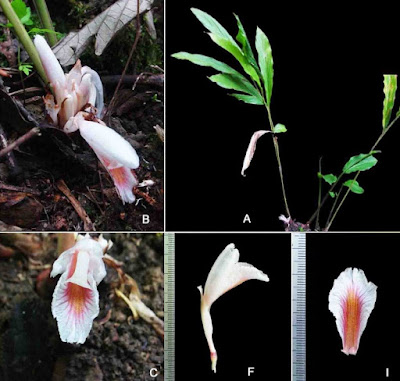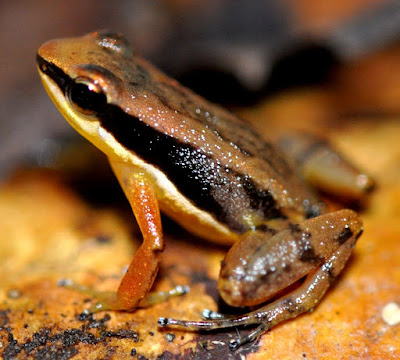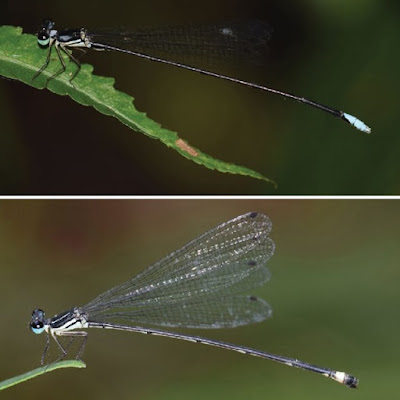[Most Recent Entries] [Calendar View]
Wednesday, January 23rd, 2019
| Time | Event | ||||
| 2:04a | [Botany • 2019] Amomum nagamiense (Zingiberaceae) • A New Species of Amomum Roxb. from Nagaland, India
Abstract A new species of Amomum from Nagaland is described and illustrated. The photographs and illustrations are provided. The species shows similarity with A. maximum in having bi-lobed ligule and white flowers and non-stoloniferous rhizome, but differs in slender habit, glabrous lamina, ligule with rounded apex, nonperishable, smaller bracteole, obtuse dorsal corolla lobe, pubescent anther lobe and ridged fruits. Keyword: Amomum; India; Nagaland; New species; Zingiberaceae Amomum nagamiense V.P. Thomas & M. Sabu, sp. nov. Similar to Amomum maximum in having bilobed ligule, white flowers, and non-stoloniferous rhizome, but differs in slender habit, glabrous lamina, ligule with rounded apex, non-perishable, smaller bracteole, obtuse dorsal corolla lobe, pubescent anther lobe and ridged fruits. .... Distribution: India (Nagaland). Ecology: Found growing as undergrowth in the semi-evergreen forest at an altitude of 1000 m asl in NE India. Etymology: Named for the Indian State Nagaland. Affinities: The species shows similarity with Amomum maximum in having bi-lobed ligule, white flowers, and non-stoloniferous rhizome, but differs in many attributes. A comparison with two other related species Amomum glabrum S. Q. Tong and A. menglaense S. Q. Tong are also presented (Table 1). Valukattil Ponnachan Thomas, Mamiyil Sabu and Vettathukattil Abdul Gafoor Muhammed Nissar. 2019. A New Species of Amomum Roxb. (Zingiberaceae) from Nagaland, India. Taiwania. 64(1); 9-12. DOI: 10.6165/tai.2019.64.9 | ||||
| 2:46a | [Herpetology • 2019] Allobates carajas • A Name for the Nurse-frog (Allobates, Aromobatidae) of Floresta Nacional de Carajás, Eastern Brazilian Amazonia
Abstract We describe a new species of nurse-frog (Aromobatidae, Allobates) from Floresta Nacional de Carajás, southeastern Brazilian Amazonia. Allobates carajas sp. nov. is distinguished from similar congeneric species by the combination of the following characters: body-size range (snout-to-vent length 16.5–19.1 mm), dorsal color pattern with a dark brown hourglass-shaped mark, by the absence of a pale dorsolateral stripe and presence of a pale ventrolateral stripe, absence of a pale paracloacal mark, by overall bright yellow ventral colors of live male and female specimens, and by the posterior labium of tadpoles, with a single row of pyramidal papillae medially. The advertisement call of the new species is highly variable, with four possible temporal arrangements of notes (continuous emission of notes separated by regular silent intervals, continuous emission of notes separated by irregular silent intervals, emission of discrete note trills, and sporadic emission of single notes). Duration of notes range between 0.020–0.060 s, and the dominant frequency of notes range from 4.75 to 5.38 kHz. The new species is currently known only from forested habitats within Floresta Nacional de Carajás. Keywords: Amphibia, Advertisement calls, conservation unit, Dendrobatoidea, mitochondrial DNA, Pará Allobates carajas sp. nov. Pedro Ivo Simões, Diana Rojas and Albertina P. Lima. 2019. A Name for the Nurse-frog (Allobates, Aromobatidae) of Floresta Nacional de Carajás, Eastern Brazilian Amazonia. Zootaxa. 4550(1); 71–100. DOI: 10.11646/zootaxa.4550.1.3 | ||||
| 10:49a | [Entomology • 2019] Coeliccia schorri • A New Species of Damselfly (Odonata: Zygoptera: Platycnemididae) from the Central Highlands of Vietnam
Abstract Coeliccia schorri sp. n. is described based on both sexes (holotype male from Dak Roong Commune, K’bang district, Gia Lai province, central highlands of Vietnam). The combination of the characters of a large pruinose spot on the synthorax, blue abdominal tip, and white appendages in the male and a long spine on the posterior pronotal lobe of the prothorax in the female help distinguish it from all other Coeliccia species. The Coeliccia hayashii-group, remarkable for the pruinose markings on the male prothorax and synthorax in combination with the structure of the genital ligula which is bifurcated from the base into two long flagella, is discussed.
Family Platycnemididae Yakobson & Bianchi, 1905 Subfamily Calicnemiinae Fraser, 1957 Genus Coeliccia Kirby, 1890 Coeliccia schorri sp. n. Etymology This species is named in honor of Dr Martin Schorr in appreciation of his support of odonatological research in Vietnam through the International Dragonfly Fund to the first author. A noun in the genitive case. Phan Quoc Toan and Van Quang To. 2019. Description of New Damselfly Coeliccia schorri sp. n. (Odonata: Zygoptera: Platycnemididae) with A Discussion of the Coeliccia hayashii -group in Vietnam. International Journal of Odonatology. DOI: 10.1080/13887890.2018.1557567 |
| << Previous Day |
2019/01/23 [Calendar] |
Next Day >> |







